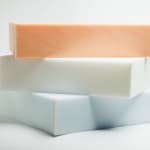
Polyurethanes (abbreviated as PU or PUR) are one of the most commonly used polymeric materials in the world. The spectrum of their applications in industry is very wide, thanks to the possibility of designing materials with very different functional properties. It is therefore worthwhile to take a closer look at these materials.
What are polyurethane materials?
Polyurethanes (PU) are obtained by addition polymerisation. The substrates in this reaction are multifunctional isocyanates, the so-called Component B, and polyols obtained from crude oil processing (Component A). Mixing these two components starts the process which produces a polyurethane material (often in the form of foam). Component A contains various auxiliary substances, such as catalysts, surfactants, stabilizing and foaming additives, that give the final material the desired properties.
The production of polyurethanes with specific functional properties is possible through an appropriate selection of proportions and concentrations of components A and B. The quantity and type of auxiliary substances used also have an important influence on the physical and mechanical parameters of the final product. Modifications in the composition of the reaction mixture enable obtaining a material with specific strength parameters (e.g. abrasion resistance) as well as different stiffness and elasticity. As a result, PUR materials can be designed for individual and most precise applications.
Polyurethane materials may be available in different forms depending on the type and proportion of ingredients used in their production. They can therefore be flexible foams (high performance, viscoelastic, soft and hyper soft foams), integral foams, one-component and two-component adhesives, sealants, polyurethane coatings, rigid and semi-rigid foams, spray foams and rigid insulation panels.
Where are polyurethane systems used?
The extraordinary versatility and variety of polyurethane materials make them suitable for many industries. One of them is the construction industry, where polyurethane systems are used for thermal insulation of residential buildings and various rooms in industry and agriculture. In this industry, spray foams with a high adhesion to the substrate and a low thermal conductivity coefficient are used in particular. They provide seamless insulation, which is characterised by the absence of thermal bridges causing heat loss.
Another area of application of polyurethanes is widely understood industry. Polyurethanes are used to insulate industrial installations (tanks, pipelines), as well as to glue and seal joints located on production lines. Polyurethane foams are also an excellent construction material for the automotive industry. They can be used to produce elements such as steering wheels, dashboards, gearbox levers and even car seats - in the latter, flexible foams are the main construction material. Polyurethanes used under the mud flaps effectively absorb impacts, while in the headliners they serve as acoustic insulation.
In the sports and recreation industry, integral polyurethane foams are used. Their application is primarily the production of high-quality saddles for bicycles and grips, as well as soles for sports footwear. Polyurethanes are also used in the rehabilitation and medical industry for the construction of wheelchairs and operating and rehabilitation tables.
In the mining industry, polyurethanes are used as very high strength binders. Two-component polyurethane foams minimize risks in mines, e.g. by hardening cracked rock mass, strengthening loosened rocks and coal seams or sealing excavations against pressurized water. In the furniture industry, polyurethanes are the fillings of upholstered furniture and the main element of mattresses.
The future of polyurethanes
The ability to modify the properties of polyurethanes enables the creation of products tailored to customer needs, which can be used in a wide range of applications.
The insulating properties of these materials are used, among other things, to create high quality materials that protect against excessive noise (acoustic insulation) and ensure appropriate thermal parameters of equipment and buildings. What is important, polyurethane plastics are characterized by high strength, which guarantees long-term comfort and safety. Thanks to these features, polyurethane materials are and will continue to be a dynamically developing group of increasingly popular plastics.



